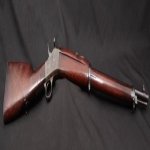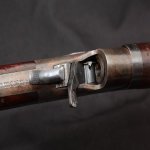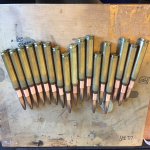Personally, I would use data for the 7x57R. Mostly used in hinged action rifles and combo guns. Consider this data as Max loads.
7X57R
Warning!#Notes:#Handloader Issue 193
Be Alert: Publisher cannot be responsible for errors in published load data.
Wt. Bullet Manufacturer Powder Charge Velocity (FPS) Favorite?
139 Hornady Spire Point boat-tail IMR IMR-4064 41 2,471
Remarks:#primer: CCI BR; group (inches): 0.44; case: RWS Boxer-primed
139 Hornady Spire Point boat-tail IMR IMR-4320 41 2,549
Remarks:#primer: CCI BR; group (inches): 0.46; case: RWS Boxer-primed
139 Hornady Spire Point boat-tail IMR IMR-4350 45 2,541
Remarks:#primer: CCI BR; group (inches): 0.37; case: RWS Boxer-primed
140 Nosler spitzer boat-tail IMR IMR-4064 41 2,459
Remarks:#primer: RWS-5620; group (inches): 0.42; case: RWS Berdan-primed
140 Nosler spitzer boat-tail IMR IMR-4320 41 2,571
Remarks:#primer: RWS-5620; group (inches): 0.57; case: RWS Berdan-primed
140 Nosler spitzer boat-tail IMR IMR-4350 45 2,517
Remarks:#primer: RWS-5620; group (inches): 1.08; case: RWS Berdan-primed
154 Hornady Spire Point IMR IMR-4064 41.6 2,439
Remarks:#primer: CCI BR; group (inches): 0.40; case: RWS Boxer-primed
154 Hornady Spire Point IMR IMR-4320 41.9 2,334
Remarks:#primer: CCI BR; group (inches): 0.68; case: RWS Boxer-primed
154 Hornady Spire Point IMR IMR-4350 46.1 2,517
Remarks:#primer: CCI BR; group (inches): 0.44; case: RWS Boxer-primed
154 Hornady Spire Point IMR IMR-4064 41.6 2,483
Remarks:#primer: RWS-5620; group (inches): 0.70; case: RWS Berdan-primed
154 Hornady Spire Point IMR IMR-4320 41.9 2,459
Remarks:#primer: RWS-5620; group (inches): 0.72; case: RWS Berdan-primed
154 Hornady Spire Point IMR IMR-4350 46.1 2,536
Remarks:#primer: RWS-5620; group (inches): 0.68; case: RWS Berdan-primed
160 Sierra spitzer boat-tail IMR IMR-4064 42 2,517
Remarks:#primer: CCI BR; group (inches): 0.89; case: RWS Boxer-primed
160 Sierra spitzer boat-tail IMR IMR-4320 43 2,586
Remarks:#primer: CCI BR; group (inches): 0.26; case: RWS Boxer-primed
160 Sierra spitzer boat-tail Hodgdon H-4350 46 2,489
Remarks:#primer: CCI BR; group (inches): 0.40; case: RWS Boxer-primed
160 Sierra spitzer boat-tail IMR IMR-4064 40 2,371
Remarks:#primer: RWS-5620; group (inches): 1.22; case: RWS Berdan-primed
160 Sierra spitzer boat-tail IMR IMR-4320 41 2,471
Remarks:#primer: RWS 5620; group (inches): 1.05; case: RWS Berdan-primed
160 Sierra spitzer boat-tail IMR IMR-4350 44 2,345
Remarks:#primer: RWS-5620; group (inches): 0.81; case: RWS Berdan-primed
175 Hornady Spire Point IMR IMR-4064 39 2,259
Remarks:#primer: CCI BR; group (inches): 0.54; case: RWS Boxer-primed
175 Hornady Spire Point IMR IMR-4320 40 2,386
Remarks:#primer: CCI BR; group (inches): 0.85; case: RWS Boxer-primed
175 Hornady Spire Point Hodgdon H-4350 44 2,310
Remarks:#primer: CCI BR; group (inches): 0.55; case: RWS Boxer-primed
175 Hornady Spire Point IMR IMR-4064 39 2,302
Remarks:#primer: RWS-5620; group (inches): 0.98; case: PS Berdan-primed
175 Hornady Spire Point IMR IMR-4320 40 2,357
Remarks:#primer: RWS-5620; group (inches): 0.88; case: PS Berdan-primed
175 Hornady Spire Point IMR IMR-4350 44 2,343
Remarks:#primer: RWS-5620; group (inches): 0.94; case: PS Berdan-primed
Have shot a friend's Danish 8x58R. Nice.





















































































